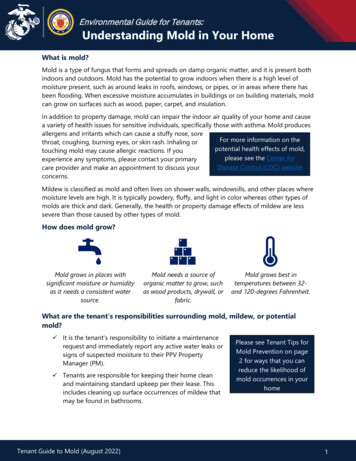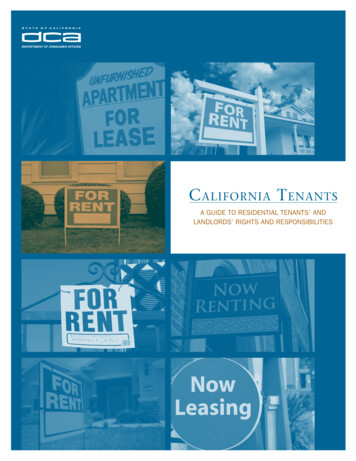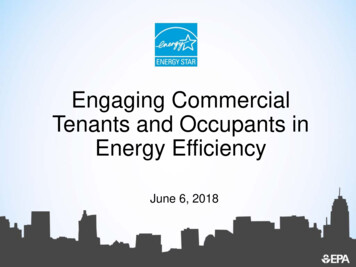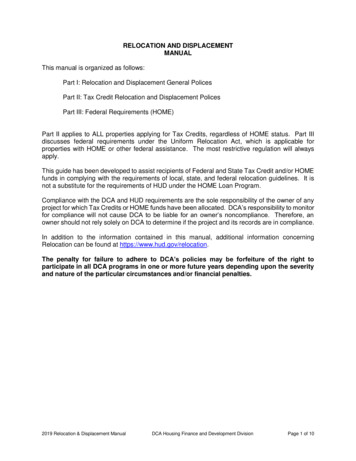
Transcription
Environmental Guide for Tenants:Understanding Mold in Your HomeWhat is mold?Mold is a type of fungus that forms and spreads on damp organic matter, and it is present bothindoors and outdoors. Mold has the potential to grow indoors when there is a high level ofmoisture present, such as around leaks in roofs, windows, or pipes, or in areas where there hasbeen flooding. When excessive moisture accumulates in buildings or on building materials, moldcan grow on surfaces such as wood, paper, carpet, and insulation.In addition to property damage, mold can impair the indoor air quality of your home and causea variety of health issues for sensitive individuals, specifically those with asthma. Mold producesallergens and irritants which can cause a stuffy nose, soreFor more information on thethroat, coughing, burning eyes, or skin rash. Inhaling orpotential health effects of mold,touching mold may cause allergic reactions. If youplease see the Center forexperience any symptoms, please contact your primaryDisease Control (CDC) websitecare provider and make an appointment to discuss yourconcerns.Mildew is classified as mold and often lives on shower walls, windowsills, and other places wheremoisture levels are high. It is typically powdery, fluffy, and light in color whereas other types ofmolds are thick and dark. Generally, the health or property damage effects of mildew are lesssevere than those caused by other types of mold.How does mold grow?Mold grows in places withsignificant moisture or humidityas it needs a consistent watersource.Mold needs a source oforganic matter to grow, suchas wood products, drywall, orfabric.Mold grows best intemperatures between 32and 120-degrees Fahrenheit.What are the tenant’s responsibilities surrounding mold, mildew, or potentialmold? It is the tenant's responsibility to initiate a maintenancerequest and immediately report any active water leaks orsigns of suspected moisture to their PPV PropertyManager (PM). Tenants are responsible for keeping their home cleanand maintaining standard upkeep per their lease. Thisincludes cleaning up surface occurrences of mildew thatmay be found in bathrooms.Tenant Guide to Mold (August 2022)Please see Tenant Tips forMold Prevention on page2 for ways that you canreduce the likelihood ofmold occurrences in yourhome1
Environmental Guide for Tenants:Understanding Mold in Your HomeWhat are the responsibilities of the PPV PM and the Military Housing Office(MHO)?PPV PMMHO Provides walkthrough inspection of atenant’s home during their move-in Advises tenants of their responsibility toprevent and immediately report anyconditions conducive to mold growth Provides tenants with clear reportingprocedures so problems can be recordedand addressed in a timely manner As the tenant advocate, applies theenvironmental health and safety standardsfor managing mold and coordinates withmaintenance personnel to resolve theissue and ensure tenant satisfaction Becomes involved with a concern if theDispute Resolution Process (DRP) isinitiated due to the PPV PM not resolvingan issueHow do I prevent mold growth?Per the Environmental Protection Agency (EPA), it is impossible to get rid of all mold and moldspores indoors - some mold spores will be found floating through the air and in house dust.Mold spores will only grow if moisture is present. The best way to prevent mold growth indoorsis to control moisture. Identifying and repairing water leaks as quickly as possible, ensuringproper air circulation, and maintaining a clean and clutter free home all contribute towardspreventing mold growth in your home. It's simple – control moisture and you'll control moldgrowth.PreparationTenant Tips for Mold Prevention Be an active participant during your move-in inspection with the PPV PM. Look for evidenceof water damage, visible mildew, or mold growth Report all plumbing leaks and moisture problems immediately to your PPV PM Check hidden locations for mold, such as ceiling and floor ventsYou can control mold growth in your home by: Controlling humidity levels indoors Regardless of the outside temperature, opening windows in your housing unit for 15minutes once a month to improve air circulation Ventilating shower, laundry, and cooking areas Running your ceiling fans to increase air circulation and/or setting the heating, ventilation,and air conditioning (HVAC) unit fan to ‘Auto’ Checking and changing your HVAC filters per directions from your PPV PM Reporting leaky roofs, windows, or pipes to your PPV PM and working with them to ensurethe problem and leak source is fixed Thoroughly cleaning and drying the problem areaTenant Guide to Mold (August 2022)2
Environmental Guide for Tenants:Understanding Mold in Your HomeHow do I spot mold in my home?Generally, mold may be recognized either by sight or smell. You can refer to the Appendix forphoto examples of molds and mildew. Mold usually appears as a distinctly colored woolly mat. For example, mildew is white,gray, or light brown, and is one of the most common molds in a household.Mold often produces a musty, earthy smell.If you know there has been a leak or water damage, if you can smell musty odor, or if othertenants are reporting health problems, there may be mold hidden in hard-to-see places. Theseinclude locations such as the back side of dry wall, wallpaper, paneling, the top side of ceilingtiles, or the underside of carpets and pads. Initiate a maintenance request and contact your PPVPM immediately if you suspect hidden mold.What should I do if there is a mold issue in my residence?If you have a mold problem, it is important to act quickly by initiating a maintenance requestand contacting your PPV PM. Mold will cause damage to whatever items it grows on, and thelonger it grows, the more damage it can cause.It's important to remember:The key to minimizing moldis moisture control.Water-damaged areas and items should be driedwithin 24-48 hours to prevent growth.How do I clean mold or mildew in my home?If mold is growing in your home, you need to contactyour PPV PM immediately for help to address theissue. Maintenance personnel will inspect potentialmold occurrences and assist in cleanup and addressany associated moisture problems if needed. If thesubstance is mildew, it is your responsibility to cleanupcommon occurrences, such as those found inbathrooms.MoldDo not selfclean. Contactyour PPV PM!MildewYou can selfclean, using thetips belowBelow are a few tips for self-cleaning: Mildew can be removed from hard surfaces with EPA-registered antimicrobial cleaningproductsIf EPA-registered antimicrobial cleaning products are not available, soap and water, or ableach solution of no more than 1 cup of household laundry bleach in 1 gallon of water, canbe used as cleaning products to clean up surface-level mildewScrub mildew off hard surfaces with your chosen cleaner and waterDry all items completelyTenant Guide to Mold (August 2022)3
Environmental Guide for Tenants:Understanding Mold in Your Home Absorbent or porous materials, such as ceiling tiles and carpet, may have to be removed ifthey have heavy occurrences of mildew. Mildew can grow on or fill in the empty spaces andcrevices of porous materials, so the mildew may be difficult or impossible to removecompletely. Work with your PPV PM to identify how to replace anything that is theirresponsibility.If you clean up the mildew, but don't fix the water problem, then the mildew problem will likelycome back.Where can I find more information on mold in my residence?The EPA and CDC have helpful resources on how to prevent and spot mold occurring in yourhome: EPA: Mold Cleanup in Your HomeEPA: Mold and Your HomeCDC: Basic Facts about Mold and DampnessCDC: Health Problems Related to Dampness and MoldCDC: You Can Control MoldTenant Guide to Mold (August 2022)4
Environmental Guide for Tenants:Understanding Mold in Your HomeAppendix (Photos of Different Types of Mold)Photos are sourced and owned by EPA.To view additional photos, visit the EPA Mold GalleryMold on drywall under leaky sinkMold on air seal on sliding glass doorMold surrounding air conditioning ventMildew found on bathroom groutTenant Guide to Mold (August 2022)5
Tenant Guide to Mold (August 2022) 1 . What is mold? Mold is a type of fungus that forms and spreads on damp organic matter, and it is present both indoors and outdoors. Mold has the potential to grow indoors when there is a high level of moisture present, such as around leaks in roofs, windows, or pipes, or in areas where there has been flooding.











